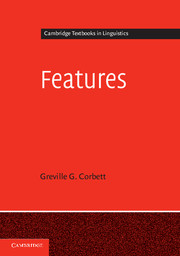Book contents
- Frontmatter
- Contents
- Figures
- Tables
- Preface
- Abbreviations
- 1 Why features?
- 2 Formal perspectives
- 3 Features for different components
- 4 Justifying particular features and their values
- 5 Typology
- 6 Canonical Typology and features
- 7 Determining feature values
- 8 Feature-value mismatches
- 9 Conclusions
- Appendix Standards and implementations
- References
- Author index
- Language index
- Subject index
2 - Formal perspectives
The internal structure of features
Published online by Cambridge University Press: 05 November 2012
- Frontmatter
- Contents
- Figures
- Tables
- Preface
- Abbreviations
- 1 Why features?
- 2 Formal perspectives
- 3 Features for different components
- 4 Justifying particular features and their values
- 5 Typology
- 6 Canonical Typology and features
- 7 Determining feature values
- 8 Feature-value mismatches
- 9 Conclusions
- Appendix Standards and implementations
- References
- Author index
- Language index
- Subject index
Summary
Recall why we use features: we wish to capture generalizations across linguistic objects. Given the items children, books, saxophones, we want to state that they are all plural, and take plural agreement. We could use plural as a label, and go on to give each object a set of such labels. But the key point is that plural is interesting because of singular. Child is not just not plural, it is singular. Thus plural is more than a label to be attached; it signals something of linguistic interest, from which other information can be derived. It is a member of an opposition, that is, it is a value of a feature, in this instance number. In a language like English, the speaker has to choose singular or plural. The choice is obligatory (an issue to which we return in §2.1.6 and in §6.5); we meet a very different type of number system in §8.1.
Various notations have been employed, including these:
children [+plural] or children [+pl]
children [plural +]
children [plural 1]
children [plural=1]
children: <plural>=1
children: <plural>=yes
plural (children) = true
The ± notation is often used with binary (sometimes called Boolean) features, as in Gazdar, Klein, Pullum & Sag (1985: 22–3); see §2.1.2 below. The notations given do not reflect significant differences. I will suggest an appropriate formalism, making the feature-value structure clear, in §2.1.2. We shall look at the general issue of the structuring of features (§2.1). Then we consider a set of specific issues relating to structuring: atomic versus complex values (§2.2), the way in which features cross-classify (§2.3), typing (§2.4) and unification (§2.5).
- Type
- Chapter
- Information
- Features , pp. 15 - 41Publisher: Cambridge University PressPrint publication year: 2012



